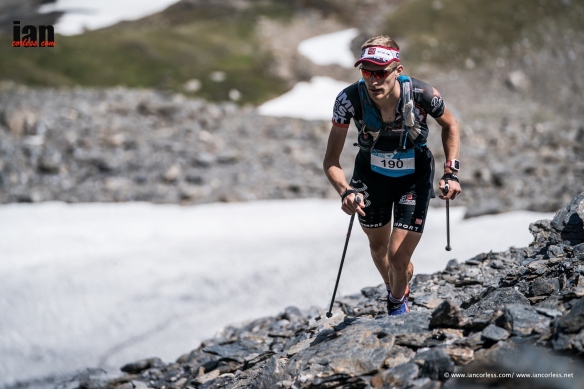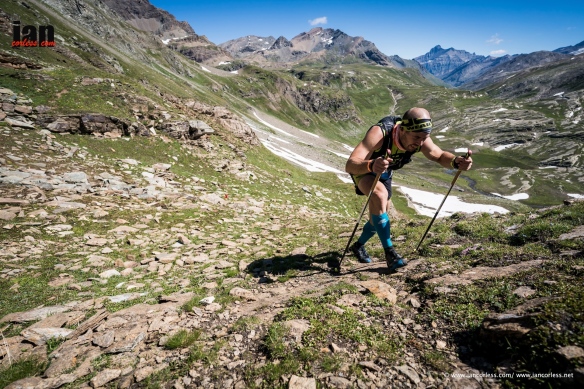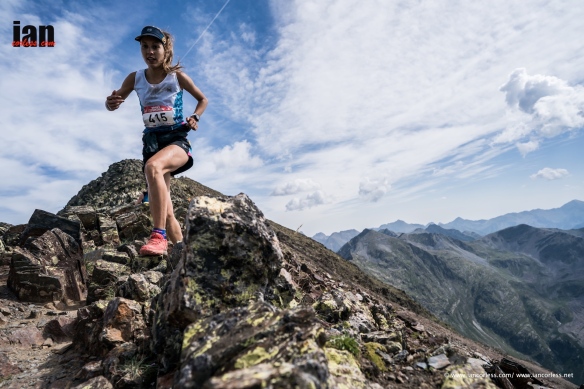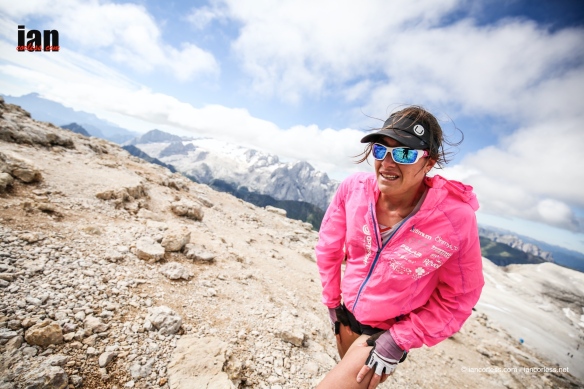
Damian Hall ran his first half marathon race in 2011. In his own words, “It was a life-changing race.” Just 1-year later he ran his first marathon and first ultra-marathon. Dedicated to the art of running, Damian became a student of the sport and through his journalism work, he gleamed as much information as possible. He became his own test subject.
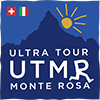
In a very short period of time, he completed the Ultra-Trail du Mont-Blanc on four occasions progressing each year to finally place 5th. He has run Marathon des Sables in the Sahara Desert,the Ice Ultra in Arctic Sweden,The Coastal Challenge in Costa and has excelled at multi-discipline and long distance races in the UK such as The Spine, The Dragons Back and the UK Trail Championships.

His love for the sport has also seen him test himself on multiple challenges and FKT’s such as running ‘The Rounds’ such as Bob Graham, the South West Coast Path and most recently the Cape Wrath Trail with Beth Pascall.
A lover of a good mug of tea and a Tunnock biscuit, Damian, the husband and father of two children, has a popular voice on the UK ultra-run scene.
Leaving his beloved UTMB alone in 2019, Damian will challenge himself in September with the Ultra Tour Monte Rosa.

Training for…, a series of new articles brought to you by the multi-stage and ultra-running specialist store, myRaceKit, http://www.myracekit.com

We are very fortunate to have myRaceKit sponsoring several articles on ‘Training for…’ in this scenario, the UTMR, the Ultra Tour Monte Rosa, an epic trail race designed by no less than Lizzy Hawker, who in herself is an absolutely stunning multi-day ultra-runner. Lizzy came up with this beast of a race, or should I say beasts of races because now there is more than one, there is the big one which is a 170 km with 11,300 meters of vertical, there is a four-stagerace which is basically the big one broken down into four days and then there are the Ultra Three Passes which is 100 km with 6420 meters of vertical gain, big statistics. I wondered, what enticed Damian to tackle the UTMR instead of UTMB in 2019?
“I thought if I’m not doing UTMB, I’ll do the race with the closest name,” Damian says with a hint of mischief. “No. I think number one, I love running a hundred miles, I think it’s a really special race distance, I also love running a hundred miles in a lumpy place because it’s just that bit more ‘hurty,’ but I think the number one appeal really for me is Lizzy Hawker actually, I’ve never met her and she’s a huge inspiration to me. When Iwas just getting into the sport, she was winning UTMB every year, and I love her outlook on the sport, I’m sure she probably wouldn’t call it a sport, it’s probably more than that to her and probably to me as well, but I’ve read her book, I love that and she’s just super inspiring. I still have that UTMB obsession to shake off, I did four UTMBs in a row and I’m looking forward to a year without one just to freshen things up and see what that feels like and UTMR, it’s not too far away either, is a similar time of year but in a way it sounds very similar and yet very different. Obviously, the crowds will be a lot smaller, the field’s a lot smaller. It sounds like a tougher course, there’s more climb. From the pictures I’ve seen, it’s possibly more spectacular. I’ve had three good friends do it including Nicky Spinks. They’ve all absolutely raved about it. There’s a whole load of reasons to be attracted to the race. I’m really excited.”
Put like that, it’s self-explanatory why Damian will venture to new ground. After all, the Matterhorn as a backdrop to stunning trails is an easy sell. It’s arguably the most iconic mountain in the world, maybe even more so than Everest. After all, Everest did not make it on to Toblerone packaging!
Damian came to this sport later in life, and in doing so, has inspired a great deal of people to relook at their own running and what they can achieve. I’ve always said, age is just a number, it doesn’t actually really mean anything. Not only are you proving that but there’s countless other people proving that. In 2014, Damian placed fourth in the Spine and second in the Cotswold Way, which was then just about over 100 miles. The following year, I raced at the Dragon’s Back, he placed 29th at UTMB. Then the following year, you came to The Coastal challenging Costa Rica where you placed fifth in a super stacked front field. Second at the Highland Fling which was a UK trail championship, a great result. You moved up from 29th to 19th at UTMB, then 19th to 12th and then 12th to 5th! Actually, 2018 was a great year for you because you won the Ice Ultra, you were sixth at Madeira and you were first at Ultimate Trails and second at Mozart 100.

“Yes, I think I’ve realized that UTMB and similar are the races I like. Long climbs and some technical aspects and fun. I suppose fun, long technical descents. I’ll be honest, I like a hiking race. I like a long climb that’s so long, you can’t really run it. I like the change in rhythm that that brings. I am not full-time but am dedicated. My progression has been gradual, and I am happy. UTMR in a way is perfect because it’s some of the similar format big mountains, similar distance that kind of thing but it feels quite fresh and that’s a new course.”
Running well for any race usually requires very specific preparation and ideally on opportunity to go and run on some of the race route.
“I’m still undecided whether I’ll be able to go on recce or not. Traditionally, I haven’t really recced races because I’m in the sport for the adventure really. Obviously, I love the athletic, the competitive element of it too. I love the adventure element where you’re not really sure what the course looks like and you’re not sure what’s of the next horizon, the next mountain, the next valley.”
A family man who works, how does Damian plan his training? How does he fit in training? What does his research look like when going into a race? So many questions come to mind! It’s very easy with the Ultra Monte Rosa course I guess, look at a map and it’s a nice big circular loop and you suddenly start to see really key statistics like Zermatt and Saas-Fee and then you start to look at everything else and then suddenly you realise there’s lots of 4,000 meter mountains in this area. It’s going to be quite a hard race. How does Damian start to approach the training process for a race like this?
“I guess the distances is a key statistic and you’d hope people would know the distance before they sign up but then it’s also how much vert as the Americans call it, how much ascent is in the race overall. What I learned from my first UTMBis actually the descending is going to hurt than the climbing. It’s always important to know roughly what that figure is and that’s going to dictate probably the latter block of my training.”
You need to be strong for a race like a long distance ultra, particularly when in the mountains, I wondered on Damian’s approach to strength and conditioning?
“I do additional strength work making sure my legs are strong enough for that. I suppose how technical is the course is something that people think about a lot and quite rightly. UTMB for example has got a couple of short technical sections, I suppose, but mostly it’s good terrain, good hard trails. I must admit I haven’t looked in detail yet at UTMR about how technical it is compared to UTMB.I have heard more technical. Strength is key and another thing I’ve done over the time is I’ve worked with Shane Benzie who’s a movement specialist on having good technique for descending, especially for the technical terrain. I still don’t always get it right. I’ve just seen some of my photos from my recent race and they’re a bit disappointing. My technique was out of step. As you get tired sometimes, old habits slip in.”
I am sure that Damian’s training is more than just going for a run, but what about speed?
“There’s volume of course, ultra-runners need volume and miles. But I’ll be going to the track as well because last year for the first time, I started doing track work. I hate it but know it’s effective. I’m 43, I’m trying to squeeze every… I guess people would call it marginal gains, but I make sure I’m as fast as can be as well legs being as strong as can be and so on. I will be going to the track.”
Vertical climbing is a key element to a race like UTMR, as well as the descending as Damian has mentioned. Breaking training down into blocks, ‘periodization’ is important, I asked Damian how he approaches these elements.
“A good plan is all about periodizing, for now, I am in a good spell of getting fast. Vertical training will come a bit later nearer the race, which thankfully is in the summer when it’s a bit more pleasant getting to mountainous places. Also, what’s changed for me over the couple of years also is that I really look forward to runningraces. Now, I think I’m more sensible in picking three or four key ones for a year. Actually, I really enjoy the training. I love training for the sake of training, which is a nice feeling, a nice place to be, I suppose.”
Adding races in to training can be difficult, especially if one of those ‘other’ races can be as important as another ‘A’ race. For example, Damian hopes to run Western States which is close to UTMR and the courses are very different.
“Yeah, at the moment, I’ve still got this outside hope or outside wish of doing Western States in late June. Obviously, some of the Western States training would benefit UTMR, but some of it would be quite different. I don’t know if I’ll be doing it yet. In a way, I can’t plan too much of that, but I know that July and August will be all about UTMR for me. That probably means a big amount of days and trying to get a lot mountain running.”

Equipment for Western States is pretty straightforward. You need a pair of running shoes, shorts, and a top, and a hydration vest, whereas UTMR is going to be something that is completely different. Variables in terrain, extremes of hot and cold, mandatory kit, poles, etcetera. I asked Damian what are some of the specifics in a mountain race in terms of equipment that he needs, must have, and then the optional extras that he takes?
“There is something special about doing a mountain race where you have a pack, where you’re feeling self-reliant, where you know you can be okay for 6, 8, 10, 12 hours with everything in your pack, maybe even 24 hours if you get off-course. I do like that. That’s mostly why I got into the sport really is to have those mini mountain ventures. I do love agonizing over what kit to take and checking the weight of everything and checking the weather and all that aspect in the few weeks beforehand. I love all that, the anticipation.”
So, what equipment does Damian take?
“I’ll take two if not three waterproof jackets because probably the last weather forecast, the day before the race, will probably determine which one I take. With UTMB, I learned in the past that the weather can do anything and you’re not really sure. You need to be prepared for bad weather in high mountains. Any jacket should have taped seams and of course one needs appropriate trousers to go with the jacket.”
“I’ll probably, depending on the time of year, take a Protec-Shell which is probably a winter jacket. I wouldn’t expect to use that, but you never know, the weather really might come in and you don’t want to be caught out. I don’t expect to race in that, but I’ll take that out with me just in case.”
“Base layers, I use merino wool because that just gives you a little bit of extra warmth. For the last two years at UTMB I’ve worn merino gloves. I’m pretty sure they’ll be on mandatory kit list. If the weather is rough, I might be taking two, I might be taking a pair of mitts to go over the top of the gloves. I imagine there’ll be some mid layer. Again, that’s a tricky one. Sometimes if you go the lightest possible then you might get caught out. Again, I’ll probably go two different options maybe a merino one and maybe a PrimaLoft. I’ll probably take a light pair of tights as well if it’s on the mandatory kit.”
“Headlamp and spare batteries are essential, I really like the Petzl NAO+ which you can program in an app. You can decide exactly how many hours you want it to last for. It’s really bright. It’s been dependable so far. Poles, I like the Black Diamond Z Pole.”
Poles have become increasingly popular in ultra-races, particularly in mountain races. Certainly, in America, you wouldn’t see anybody using poles. I think that’s primarily because the terrain out there is probably more runnable. I’m not saying that they don’t have plenty of vert. For example, Hard Rock has got plenty of vert. Hard Rock is a good example because now if you look at the elite field in Hard Rock, they’re pretty much all using poles. Poles have become almost the ‘go to’ in races like UTMB and all these other mountain races but a lot of people think that they can just pick up a pair of poles the day before a race and use them. There is absolutely a real skill to using poles. Damian has used poles on many occasions, I wondered about his thought process?
Read about using poles HERE
“Poles still causing some debate definitely in some British circles where I think they still get called cheat sticks. About whether they’re really useful or not, in the last couple years I’ve seen definitely even people like Jim Mann and Nicky Spinks, Jasmin Paris and so on use them. Personally, I think they help me with long climbs. I can’t prove they do really unless I suppose I did a huge climb without them and then a huge climb with them to compare. I suppose I’ve never actually done that. Some of it may be psychological. You might feel you’re climbing better with them, but I really believe in this sport the mental side is so important. If you think you’re climbing well, then chances are it will help, positive mindsetis key and think. I really feel they helped with climbing. It’s not just spreading the load of the muscles. It keeps you more upright as well which can aid your breathing. It also means your muscles, especially your quads, get less stress because there’s always a temptation to bend. Practice in training is essential, especially on your long runs. Also, press-ups are excellent to tone the required muscles.”
“Also, the better your arms are moving your legs tend to follow your arms. If your arms are keeping a decent cadence your legs are hopefully not being too lazy and keeping a decent smaller cadence. A bigger cadence but a smaller gap, smaller stride. That’s what I found. I also try hard to tuck them away for any flats or downhills because I think they seem to slow me up. I think that’s a cadence thing where if you’re holding poles your arms move less and therefore your legs can move less. Poles also aid travelling down hill, sometimes I’ve been so wrecked that my quads have needed the extra help on the downhill.”

Safety is a key element in mountain races, the need for minimum calories, minimum liquid, a mobile phone and so on. I wondered if Damian had witnessed key changes?
“When I started out in the sport, I think I’d usually go with a bladder, that seemed to make more sense but the last few years I’ve been using soft flasks. I think it’s easier to see how much water you’ve got and to monitor how much you’re drinking. For example, at Station A, you might just fill them both up and try and drink them both by the time you get to the next one. I think if I need to carry one and a half, I’d probably just take three soft flasks. One might stay in the back of my pack depending on how hot it is. If it’s getting hot I’ll maybe bring that into play, but what I’ve learned as well as sometimes you have a third one that’s full of water and you use that for tipping over your head if it’s really hot rather than drinking because it can be more important to bring the body temperature down, definitely what I learned at Costa Rica! In regard to nutrition, it goes in waves and it constantly changes, I usually go with one gel and some nuts to be honest because nuts are high calorie per weight. If you are in trouble or you found someone else is in trouble, the sugar from a gel is going to help them quicker. Emergency food is very personal. In addition to a phone, often a space blanket or even a form of bivvy bag is required along with a whistle and compass. It all makes sense. Now I even would consider a GPS like a Garmin inReach as a really useful safety addition.”

Most mandatory kit lists include whistle and compass, that’s pretty normal. Some sort of elastic bandage or strapping is also useful should you have a bad ankle or a knee that you can strap it up is useful. Also, your own cup just makes sense.
“Yes, definitely, it is kind of horrifying especially in road running. I’m not trying to beat up on road running necessarily but when you see a city half marathon or marathon. Then you just see the debris left behind afterwards of water bottles. I don’t know how practical it is to turn that to road races and stuff but obviously, this is the way forward. We’re all in the last year or two become really aware of plastic wastage and yes it’s horrifying some of the stuff we’ve seen in the oceans.”
Finally, I asked Damian for a top-tip to get ready for UTMR.
“There are a few things. An obvious thing is a bit more strength work which obviously has other benefits and should help prevent injury and stuff. I must credit Ian Sharman who used to coach me, his signature session is probably the weight vest hike which I’ve become a fan of, and a weight vest is only probably only about £30 or £40 online, maybe eight to 10 kilograms and you wear for half an hour at a time, one or two miles, ideally a little bit of hill involved. Not running and just hiking you definitely don’t run downhill because that’s a hell of a lot of weight to go through your knees. If you just get in the habit of doing a short walk, often for people it’s a dog walk maybe, that can grow a bit of strength quite safely.Ultimately if you live somewhere flat it’s probably a good idea if you can sometimes get away to somewhere lumpier and do some specific training. Personally, I live near Bath in the bottom of the Cotswold’s, I go to the Brecon Beacons quite regularly, which is a three-hour round trip for me. The longest climb there still is just only 400 meters, that’s not even half of what it will be in the Alps, but one can do repeats.”
One thing is for sure, in any running adventure, if you want to progress and perform, you need to be specific. Damian has applied these principles and year-on-year, as he has learnt and has progressed. It’s not just the ‘running’ part but the planning, the equipment, the strength, core, nutrition and importantly the mind. To achieve one must address all those aspects to perform.
Training for…A series of new articles brought to you by the multi-stage and ultra-running specialist store myRaceKit, http://www.myracekits.com.

MANDATORY EQUIPMENT for UTMR
Mobile Phone – HERE
Head Torch and batteries– HERE
Bottles x2 or bladder (1.5ltr) HEREor HERE
Emergency food (400 cal)– HERE
Bivvy bag– HERE
Whistle
Elastic bandage– HERE
Drinking cup– HERE
Waterproof jacket w/ hood– HERE
Waterproof trousers – HERE
3/4 or full run tights– HERE
Warm hat– HERE
Gloves– HERE
GPS tracker (provided)
Identity papers– Passport is required in a waterproof bag
Rear light– HERE
Thermal warm layer– HERE
Run pack– HERE
Poles– HERE
Dry Bag– HERE
LINKS:
myRaceKit – HERE
UTMR – HERE
Damian Hall – HERE
Listen to the ‘Training for…’ article on Talk Ultra Podcast HERE
Join Ian Corless in London with Lizzy Hawker @lizzihawker in June for a special @myRaceKit #Tailsfromthetrails couple of days!
.
.
![]()
![]()





































